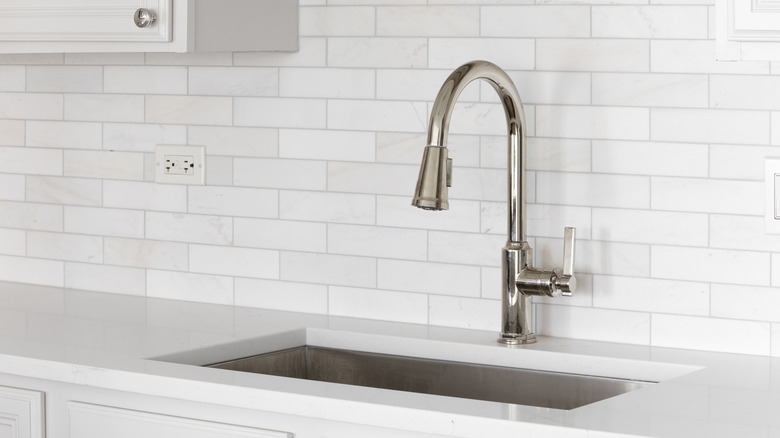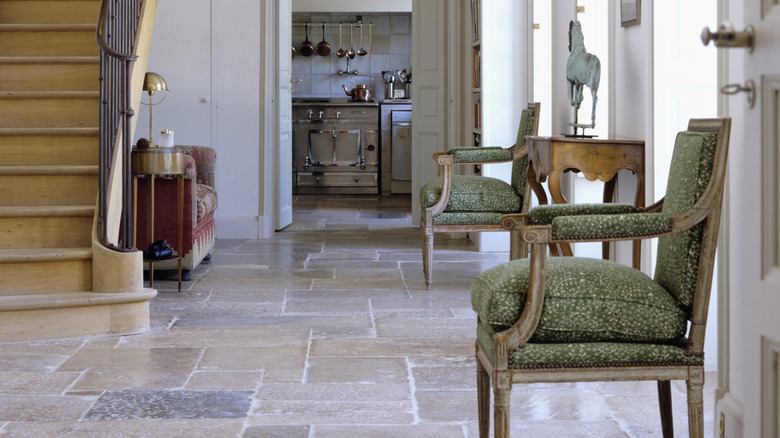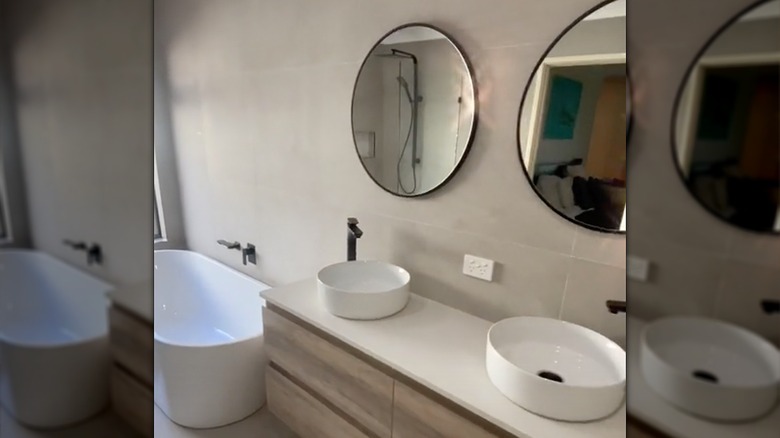The Trendy Tile Option That's Replacing Tired And Dated White Marble
White marble tile has dominated trends for years, and for good reason. This natural stone is classic, simple, and easy to style, making it an approachable choice for plenty of spaces. After so long in the spotlight, however, people are beginning to grow tired of the look. This outdated tile trend can often lean clinical thanks to its cool white color, and after seeing it featured in nearly every bathroom or kitchen remodel, it has lost its once appealing and unique feel. Fret not: if you've been searching for an alternative, there's another natural material on the scene that's ready to take over.
Natural colors, textures, and materials have been all the rage in design lately, so it makes sense that limestone is rising up to take white marble's crown. This material has plenty of the same benefits — it's neutral, so it's easy to pair with other colors and materials; it's classic, so you don't have to worry about the trend fading as soon as you complete your remodel; and it's natural, so it has subtle variations throughout the tiles that can help add texture and break up the space. Just like with any material, however, it's important to learn how and where to style it to guarantee the best results, both aesthetically and functionally.
What to consider before choosing limestone
As with any other natural stone, limestone has its pros and cons. One of the major draws is, of course, the look. Where marble is sleek and elegant, limestone feels more cozy and rustic. This is a major benefit if you tend to lean more towards warm-toned spaces or want to bring the cottagecore aesthetic into your bathroom or kitchen. It's also typically less expensive than marble, so making the switch could be an easy way to free up some space in your home renovation budget.
Unfortunately, the reduced price does come at a slight functional cost. Compared to marble, limestone is softer and, therefore, more susceptible to damage. This can include chips, cracks, and scratches from impact, but it's also something that you should keep in mind in high-moisture areas. The porosity of limestone can make it easier to stain, so if you have messy kids or pets, it's probably not the best option for you. To protect against this staining, you'll also need to reseal your limestone surfaces every few years, which can be a minor annoyance at best and a financial hurdle at worst. Of course, keep in mind that marble can also be stained and needs to be sealed often.
How to style limestone tile
There are plenty of different ways to style limestone tile, but the final look will, of course, depend on your personal interior design goals. Limestone is most commonly seen in light, slightly warm-toned colors like beige, cream, and ivory. These shades are also, conveniently, the easiest to pair with other elements in your space. Stick to an entirely neutral color scheme to create a cozy, relaxing, and spa-like atmosphere, then finish off the look with other natural materials like wood, rattan, and clay. With a more subtle shade of limestone, you could also incorporate more color with your accents, using it as a simple base to build upon.
If you're going for a bolder look, there are also some less common options for limestone that can set your space apart from the others. Gray, blue, and black limestone is perfect for those who still want to stick to a cool color scheme, while brown and red stone can provide more depth and help to up the saturation in your space.
Regardless of what color you choose, it's important to consider the functionality of limestone before installing it. When it's properly sealed, this material can do well as flooring (both indoors and outdoors), as a tiled countertop, and as a backsplash. With that being said, however, it is still prone to staining. A bit of spilled lemon juice or tomato sauce could lead to permanent damage, so it's best to reserve it for use in spaces where you know you're unlikely to make a mess.


